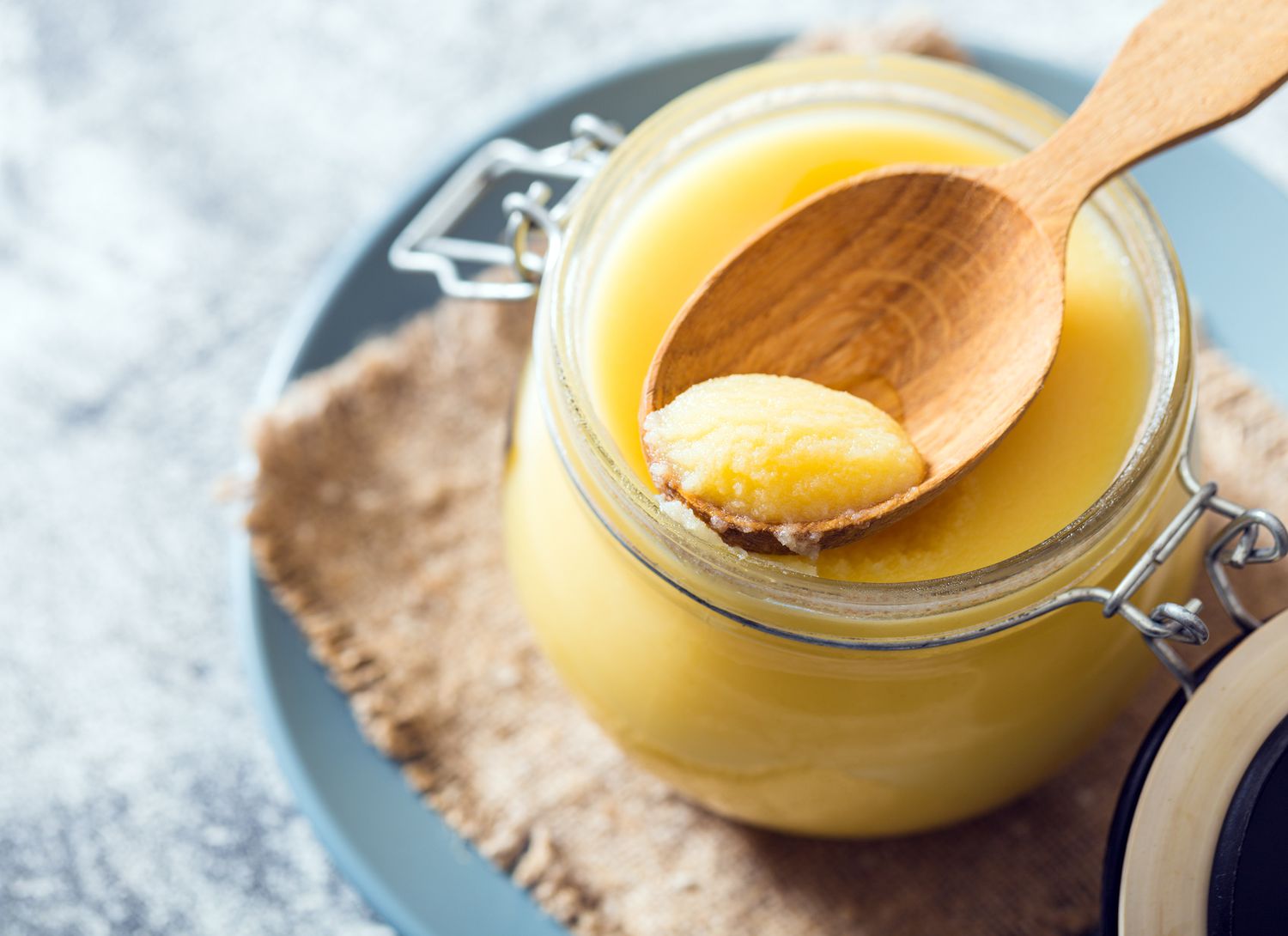
The Difference Between Ghee and Butter—and When to Use Each
From frying to baking, butter is a basic ingredient for many home cooks; for others, ghee is golden. When comparing ghee vs. butter, are there times when one product rules over the other? Both are endlessly versatile and delicious—and there’s probably room in your repertoire for both of them. We connected with a chef and a nutritionist and picked up some pointers about when to use each, including how to make ghee at home.
What Is Butter?
Butter is a dairy product made by churning milk or cream into a semi-solid fat and is sold in salted or unsalted sticks, blocks, or tubs of whipped butter. The dairy aisle also boasts European cultured varieties, which have live bacterial cultures added and a more buttery, slightly sour taste.
A pat of butter added to a baked potato or slathered on toasted blueberry muffins is, in a word, heavenly. Compound butter, flavored with fresh herbs, garlic, spices, seeds, or mustards, is a cook’s secret weapon.
What Is Ghee?
Ghee is also a dairy product and used extensively in Indian and Middle Eastern cooking—it is similar to clarified butter (which is butter with the milk solids removed) but with a few differences. It is traditionally made from unsalted butter and sold in sticks, glass jars, and tubs. It’s stocked in the dairy case or the international aisle at grocery stores.
Is Ghee the Same as Clarified Butter?
While ghee is sometimes denoted as clarified butter, there are distinctions. “While ghee and clarified butter may seem similar, they are not quite the same,” says Bhavin Chhatwani, executive chef of Tamasha Modern Indian restaurant in Raleigh, NC.
Clarified butter, he explains, is made by gently heating butter to separate the milk solids and water from the fat. The result is a clear, golden liquid with a mild flavor. Ghee takes the process a step further than clarified butter. After separating the milk solids, it is cooked until the solids brown slightly, says Chhatwani.
The Flavor of Ghee Sets It Apart
That browning makes ghee more aromatic than clarified butter, with a taste akin to browned butter. “It imparts a rich, nutty, and slightly caramelized flavor. It’s the depth of flavor that sets ghee apart,” he says.
Ghee vs. Butter
Butter has about 80 percent butterfat, with the balance comprised of water and milk solids. Ghee is 100 percent butterfat; it’s also considered a dairy product—with a difference.
Dairy Delineation
“Ghee is nearly lactose-free,” says Pamela Nisevich Bede, MS, RD, CSSD, LD, and global nutritionist for Abbott’s Lingo, noting that the water and milk solids removed from the heated brown butter contain lactose and casein.
Nutritious fat: “What’s left is a clarified fat that’s gentler on digestion and great for those who might be sensitive to dairy,” she says. In Ayurvedic traditions, Chhatwani adds, it’s considered to have health-promoting properties, not only aiding digestion but also boosting immunity.
Ghee still contains minute amounts of lactose and casein, so anyone with dairy allergies should refrain.
The Texture Of Ghee Compared to Butter
Butter is smooth, creamy, and delightfully spreadable, especially when you bring a crock to room temperature. Ghee’s texture can be smooth, but it can also be grainy and solid, depending on how it’s cooled and where it’s stored.
Storing Ghee vs. Storing Butter
Ghee has a long shelf life due to its low moisture content, Chhatwani points out, and doesn’t require refrigeration. Properly stored, butter lasts about 3 to 5 months in the refrigerator.
When to Use Ghee
“Ghee offers several benefits that make it a prized cooking fat, especially in Indian cuisine,” Chhatwani says.
Smoke point: In addition to flavor, one of the most pronounced pluses is that it has a high smoke point, around 485°F, so it doesn’t burn as easily as butter. That attribute makes it a kitchen staple for everything from sautéeing vegetables to searing proteins, Bede says.
Dish-dependent: Chhatwani says whether ghee is the better alternative to butter depends on the dish and personal preference. “For Indian cooking or high-heat applications, ghee is often the superior choice due to its stability, versatility, and distinctive flavor.”
How to Enjoy Ghee
“For me, ghee is not just an ingredient—it’s a way to add tradition, richness, and flavor to every dish,” Chhatwani says. It’s a cornerstone of his cooking, and he uses it in countless ways. Here’s how to incorporate ghee into savory and sweet dishes:
Tempering spices: “One of my favorite techniques is tempering spices in ghee (known as ‘tadka’ or ‘chaunk’), which draws out their essential oils and creates a fragrant base for dals, curries, and rice dishes,” Chhatwani says. Try using ghee in our Golden Dal With Gingered Tomatoes, Toovar Dal, and Slow-Cooker Indian-Style Fish Curry.
Sauteing, frying, and roasting: Chhatwani relies on ghee for sautéeing, frying, and roasting. I love using ghee for sautéeing vegetables, searing paneer or meats, and even frying parathas, as it adds a rich, golden crust, he says, referring to the flakey Indian flatbread. The nuttiness of ghee enhances our Sautéed Baby Broccoli and our Bell Pepper Sauté.
Desserts: Ghee shines in desserts as well, Chhatwani says. “It brings depth to traditional Indian sweets, like halwa and laddos, and I even use it in baking, where it lends a warm, nutty undertone.” Puddling-like haalwa is made with semolina or carrots, nuts, or cardomom; consider experimenting with our Carrot Cake and our Apple-Cardamom Brown-Butter Dutch Baby. Or stir ghee into the batter of our Lemony Brown-Butter Crinkle Cookies.
Popcorn: Move over butter—ghee can also elevate popcorn. Use it for popping purposes, drizzle it over a freshly popped batch, or try swapping it for butter in our Peanut Popcorn Balls.
Homemade Ghee
“Homemade ghee carries a beautiful aroma and deeper flavor, much like the traditional ghee made in Indian kitchens,” Chhatwani says. It’s also a cinch to make your own pure, golden ghee. Here’s his method:
- Gently simmer unsalted butter.
- As it melts, the water evaporates, and the milk solids separate.
- Let the solids brown until they turn golden and release a nutty aroma.
- Strain the liquid through a fine sieve or cheesecloth.
- Store in an airtight jar or other lidded container.










